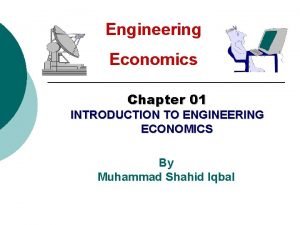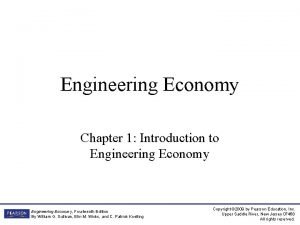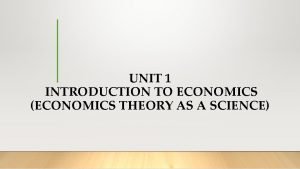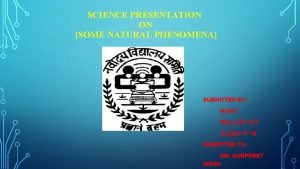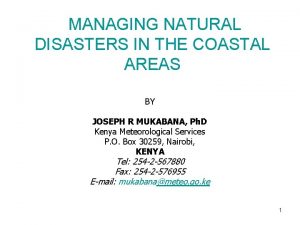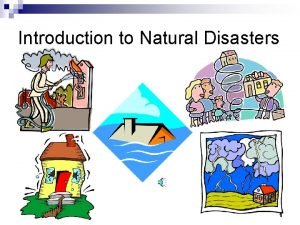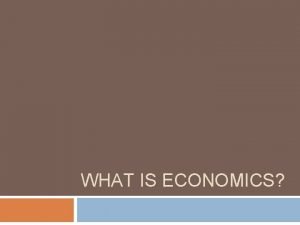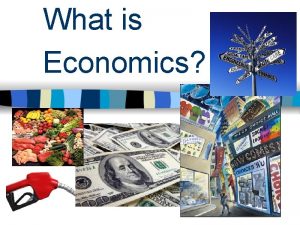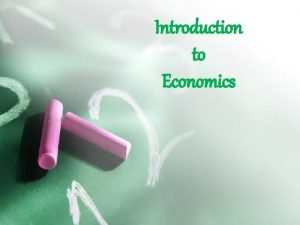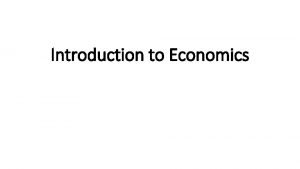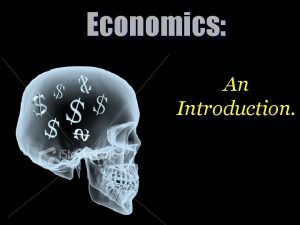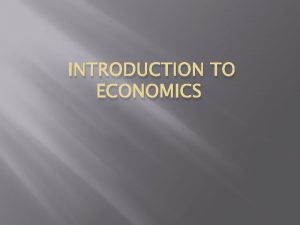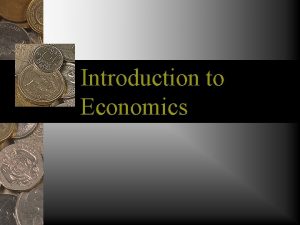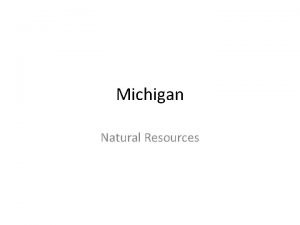Introduction to Natural ResourceEnvironmentalEcological Economics Natural resourceEnvironmentalEcological economics
















- Slides: 16

Introduction to Natural Resource/Environmental/Ecological Economics Natural resource/Environmental/Ecological economics may be envisioned as the study of choices people make in production and consumption regarding the natural world and how these choices affect the allocation and distribution of welfare to other people and the natural world n Welfare: “well-being” of individuals, organizations, societies n Distinctions between business, society, and the natural world Economics: study of how individuals and societies allocate scarce resources; a science of decision-making n Scarcity is the basis of any economic problem—no scarcity, no problem w Free good: object or concept where supply far, far exceeds demand n examples: n Scarcity: condition where wants exceed available supply CSS 383 D. J. Nalle 1

More on scarcity… Scarcity pertains to both wants (demand side) AND amounts available (supply side) Measuring scarcity… need to incorporate value as well as current and future quantities w w w n soiled underwear lying in the gutter gallon of ocean water grilled cheese sandwich dinner date your daily oxygen intake (ability to create or enhance desire is part of marketing) w marketing tries make demand curve more vertical n combining current values with available amounts and expected abilities to make more is a measure of scarcity w Renewable vs. non-renewable resources CSS 383 D. J. Nalle 2

Pricing… When wants exceed supplies, must decide how to allocate scarce goods or resources n Typical measure is price; price is an allocation mechanism w tickets to next Vandal football home game and scalping In a capitalistic environment, items are allocated to people who are willing to pay more than others for that item (one measure of fairness, one measure of efficiency) n governmental intervention to impose fairness if society perceives that market prices to do allocate fairly arguable that price contains huge amounts of information (current and future amounts, abilities to make more, how valued by society) n high prices are their own solution; same goes for low prices w mean-reverting price behavior Does price = value? CSS 383 D. J. Nalle 3

What is the price of an Old-growth forest? Of an endangered species? Need to know: how much remains? how much will be available in the future? how much can be produced in the future? how do individuals today and tomorrow value it? In natural resources, often imperfect measures of value n multiple attributes that are valued differently by different people and societies and across generations n old-growth forest in Senegal w Price to preserve (from the West), price to use by local people; studies repeatedly show that people who depend on a resource the most for their own sustenance are willing to pay the least for its use… make sense? CSS 383 D. J. Nalle 4

Scarcity, choices, and opportunity cost Scarcity causes people to decide how much they value a good or service. Value is a human construct. Without people, there is no value. Value is also relative. People value one good or service relative to another. People who possess scarce resources must determine values of goods relative to what they possess, as well as to values of the goods and services available (tradeoffs). These values are often specific to the individual. n Given a budget, maximize “utility”; each person’s budget amount is different and likely so are utility functions Opportunity cost: most highly valued alternative foregone when a choice is made to obtain some amount of a scarce good or service. Applies to individuals as well as and societies. CSS 383 D. J. Nalle 5

Opportunity cost examples We tend to think of cost in terms of money and sometimes time. Opportunity cost includes these as well as all other attributes of the next best alternative choice. Traditional economic theory assumes individuals and societies are rational in that they will choose the alternative with the highest “value”. To find the opportunity cost of a choice you made, list benefits and costs of your choice as well as those for all alternatives. (can be quite difficult, and not all alternatives will have the attributes) College vs. work vs. drifter Getting drunk the other night vs. other things could have done Not killing your roommate vs. … Not developing green space within a city boundary vs. … CSS 383 D. J. Nalle 6

Opportunity cost computation—which has the highest value to you? Alternatives (a) kill your roommate (b) maim your roommate (c) passive aggressive towards roommate (d) move out (a) Benefits satisfaction from death reputation of dominance (b) satisfaction from injury, … (c) legally “get back” at them (d) avoid costs of (a), (b), (c) CSS 383 D. J. Nalle Costs arrest (embarrassment) trial and jail (time and money) foregone income, future opps. similar to (a) drama perception of losing, time and moving costs 7

Conceptual distinctions in Economics Efficiency vs. Equity n Efficiency: using resources to best meet your objective(s) w technology vs. manual labor, whether or not to outsource, building a Wal-Mart Superstore w are natural capital and labor substitutes or compliments? n Equity: fairness of decisions made w how to distribute, who has to pay, who gets what n inter-generational equity (fairness across generations) n inter-regional equity (e. g. , industrialized nations vs. developing) n inter-personal equity (e. g. , taxes) w supply-side subsidies CSS 383 D. J. Nalle 8

Conceptual distinctions in Economics Normative vs. Positive Economics n Positive economics: what is without value judgments w Logically testable hypotheses; usually relating to efficiency n Normative Economics: value judgments (“should”, “it’s wrong to”, …) w Not usually testable, usually relating to equity issues Micro vs. Macro n Micro: individual and firm-level decisions n Macro: regional, national and international issues CSS 383 D. J. Nalle 9

Roles of Gov’t Decides how to allocate (who gets what), what to produce, how much to produce most efficiently how to assign value? n Free market: allocation based on price n Brute force: little or no personal choice n Queuing: often used with fixed-price (or non-priced) goods n Random selection: e. g, The Draft, hunting licenses n Tradition: based on precedence (e. g. , water rights in western U. S. ) n Others: Decides how to distribute or redistribute—about equity (normative economics) n Examples: Community stability and protection (cut-out-and-get-out policy driver; responses such as Multiple Use Sustained Yield (MUSY)); CSS 383 D. J. Nalle 10

Edgeworth Box Graphical demonstration of distribution and allocation of 2 goods in a 2 -person economy For good A, let x. A = amount of A controlled by person 1 y. A = amount of A controlled by person 2 For good B, let x. B = amount of B controlled by person 1 y. B = amount of B controlled by person 2 Let Tot. A = amount of A available, let Tot. B = amount of B available y. B 0 x. A y. A 0 CSS 383 D. J. Nalle x. B 11

Edgeworth box (con. ’t) Endowment: what each person controls n each person is endowed some amount of good A and B, they then trade A and B until each is satisfied w means of evaluating gains from trade n n outcome of game is determined by initial endowments and how each person values goods A and B relative to each other one version: person 1 gets initial endowment of x. A and y. B, person 2 gets initial endowment of Tot. A – x. A, Tot. B - y. B If multiple people play, can estimate relative demand relative prices of the two goods A and B by plotting each person’s price and quantity after trading is done. CSS 383 D. J. Nalle 12

The natural world Since we have “nature” around, it seems to have a non-negative value to society n multiple benefits, some of which are w substitutes (can exchange some amount of one for some amount of another): w complements: (things that go together): n marginal benefits: changing the amount of some benefit impacts the value of that benefit and others w if 20 elk remain, 1 additional elk is worth more than if there were 200, 000 and 1 more was added n recall: law of diminishing returns Individuals and societies attach different values to these benefits n between individuals… w campground on a NF n between societies… w food vs. wilderness CSS 383 D. J. Nalle 13

Sustainability U. N. definition (1987): “Meeting the needs of the present without compromising the ability of future generations to meet their own needs. ” n so what are the needs of future generations? n how can they be met? what new science/insight will we have in the future? Precautionary Principle (1988): if consequences of some action, even if such consequences are unknown, are perceived to have high risk of negative impacts, then the action probably should not be taken normative or positive economics? n not science (ask J. Franklin) n if applied to adaptive management, what sorts of decisions might managers make? CSS 383 D. J. Nalle 14

Viewpoints of and mechanics of sustainability Economic (production, consumption, and investment; note: for present and future) Ecological (environmental function) Social (welfare (think quality of life)) Time n how long to plan for? n are temporary disruptions OK? Recognition of unknown future technology and preferences How to measure? CSS 383 D. J. Nalle 15

More current definition of sustainability (or Resiliency, Adaptability) Sustainability Criterion (Arrow et al. 2004) n Does current consumption permit future generations to enjoy same standard of living? n Yes/no for determining whether we are consuming too much today n Two components: 1. consumption today 2. investment for future consumption or further investment What’s wrong with consumption? All about tradeoffs CSS 383 D. J. Nalle 16
 Maastricht university school of business and economics
Maastricht university school of business and economics Non mathematical economics
Non mathematical economics Introduction to economics
Introduction to economics Introduction to engineering economics
Introduction to engineering economics Unit 1 introduction to economics
Unit 1 introduction to economics Introduction to engineering economics
Introduction to engineering economics Unit 1 introduction to economics
Unit 1 introduction to economics Natural hazards vs natural disasters
Natural hazards vs natural disasters Natural capital and natural income
Natural capital and natural income Introduction for natural vegetation
Introduction for natural vegetation Some natural phenomena class 8 ppt
Some natural phenomena class 8 ppt Natural disasters definition
Natural disasters definition Definition of disaster
Definition of disaster Introduction paragraph format
Introduction paragraph format What is economics
What is economics Causes of scarcity
Causes of scarcity Shortages occur when
Shortages occur when



